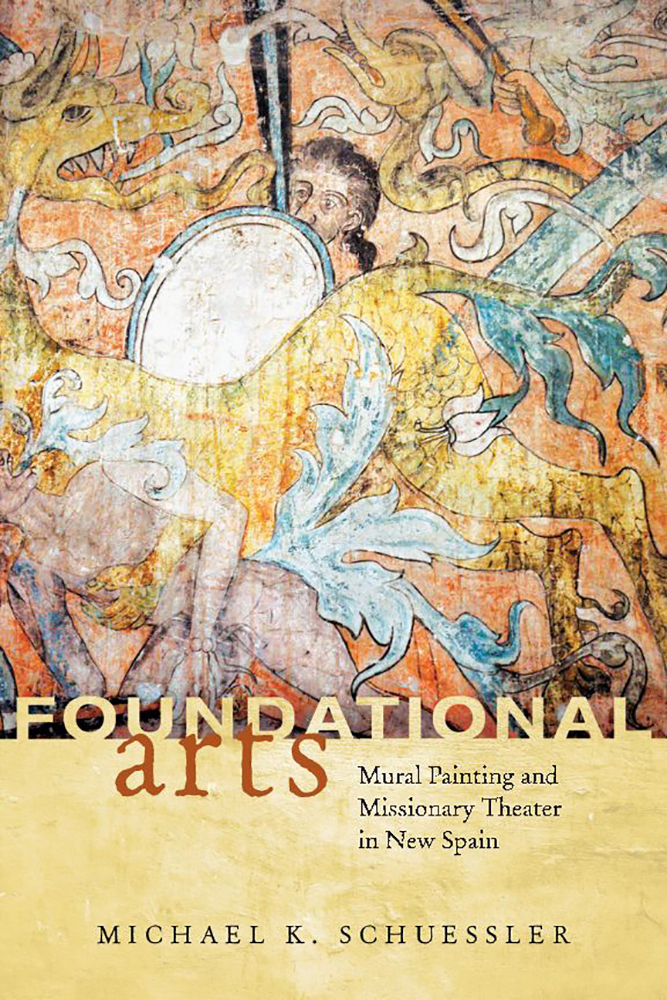Foundational Arts
Mural Painting and Missionary Theater in New Spain
Hardcover ($52.00), Ebook ($52.00)
Buy
The languages of two hemispheres collided when Spain conquered Mexico, and as a result, a dynamic expression of visual and dramatic arts emerged. Mural painting and missionary theater quickly became the media to explain and comprehend the encounter of indigenous peoples with Christ and the crucifixion, as well as with heaven and hell.
In Foundational Arts Michael K. Schuessler asserts that the literature of New Spain begins with missionary theater and its intimate relationship to mural painting. In particular, he examines the relationships between texts and visual images that emerged in Mexico at two Augustinian monasteries in Hidalgo, Mexico, during the century following the Spanish Conquest. The forced combination of the ideographical tradition of Nahuatl with Latin-based language alphabets led to a fascinating array of new cultural expressions.
Missionary theater was organized by ingenious friars with the intent to convert and catechize indigenous populations. Often performed in Nahuatl or other local languages, the actors combined Latin-based language texts with visual contexts that corresponded to indigenous ways of knowing: murals, architectural ornamentation, statuary, altars, and other modes of visual representation. By concentrating on the interrelationship between mural painting and missionary theater, Foundational Arts explores the artistic and ideological origins of Mexican plastic arts and literature.
In Foundational Arts Michael K. Schuessler asserts that the literature of New Spain begins with missionary theater and its intimate relationship to mural painting. In particular, he examines the relationships between texts and visual images that emerged in Mexico at two Augustinian monasteries in Hidalgo, Mexico, during the century following the Spanish Conquest. The forced combination of the ideographical tradition of Nahuatl with Latin-based language alphabets led to a fascinating array of new cultural expressions.
Missionary theater was organized by ingenious friars with the intent to convert and catechize indigenous populations. Often performed in Nahuatl or other local languages, the actors combined Latin-based language texts with visual contexts that corresponded to indigenous ways of knowing: murals, architectural ornamentation, statuary, altars, and other modes of visual representation. By concentrating on the interrelationship between mural painting and missionary theater, Foundational Arts explores the artistic and ideological origins of Mexican plastic arts and literature.
"Based on a wide array of meticulously scrutinized sources, Schuessler’s conclusions will unmistakably stand the test of time. Unlike some books that rest conclusions on weak foundations, Schuessler carefully pieces together large amounts of evidence to discern the hidden transcripts in the sources consulted."—Robinson A. Herrera, author of Natives, Europeans, and Africans in Sixteenth-Century Santiago de Guatemala
“Reminiscent of the hybrid codices created by pre-Hispanic tlacuilos (scribes), in this passionate and well-documented study, Michael K. Schuessler explores and analyzes the inseparable relationship between the dramatic and plastic arts as they developed and coalesced during the first decades after the Spanish Conquest. The result of this exceptional syncretic process was the birth of Mexican literature and art per se, neither indigenous nor European but something entirely unique to the remarkable—and painful—manner in which New Spain was born.”—Sara Poot-Herrera, author of Los guardaditos de Sor Juana
“Schuessler’s book creates a fascinating comparative analysis of art and literature, spanning the roots of Mexican iconography and beyond.”—Bulletin of Spanish Studies
 The University of Arizona Press
The University of Arizona Press

